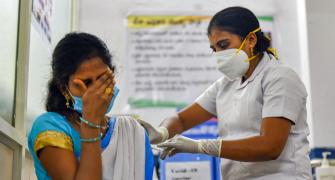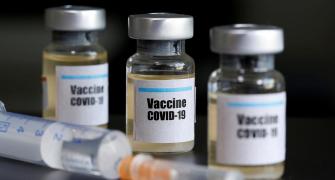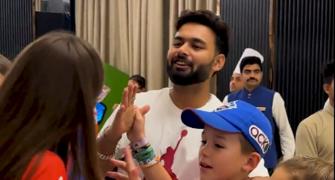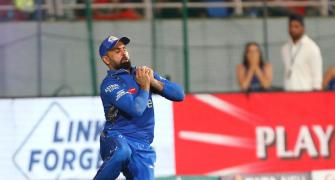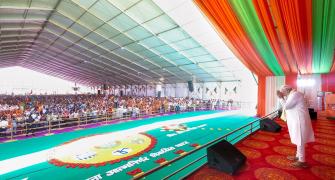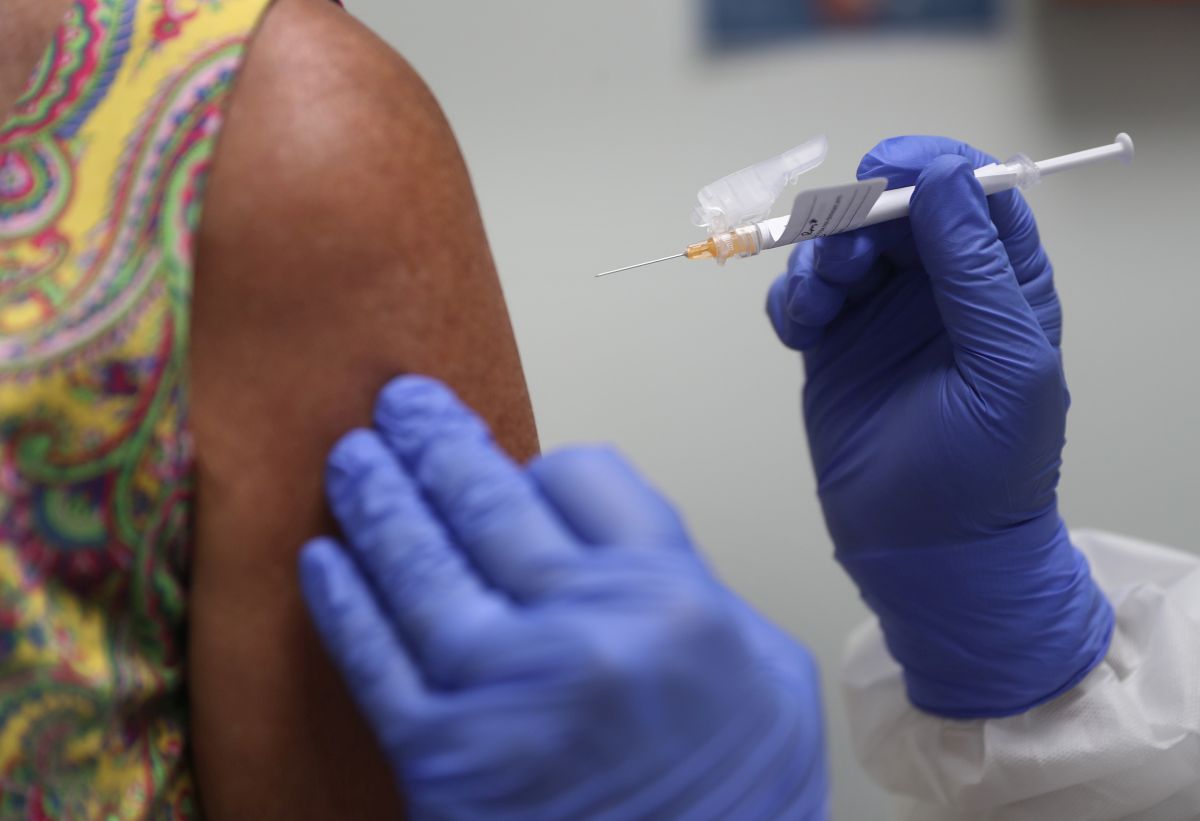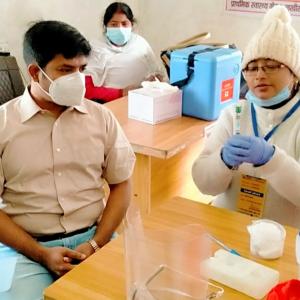'It is absolutely important for us to continue to message to people that they must wear masks, keep physical distancing, as much as is practically possible, at work or at home.'

March is upon us.
Must we beware of the Ides of March?
Will March bring any worrying changes for India?
Will our people have to crank up the battle against COVID-19 a few notches up?
Can the new strains of COVID-19, floating about Europe, the US, Brazil and South Africa, bringing those places fresh dark clouds of despair and sorrow, threaten us?
As always COVID-19 brings question marks in its wake.
Misinformation and misery.
Uncertainties and unhappiness.
But never enough answers.
Dr K Srinath Reddy, president of the Public Health Foundation of India, a non-profit working for a 'healthier India', feels India has been fighting the good fight and performing quite decently because "there has been a good collective national response."
Yet the virus causing COVID-19 will continue to wax and wane across our sub-continent, playing hide and seek or sometimes a game of tag/dhapa, and will stubbornly not just dramatically exit with a simple backward goodbye wave.
Dr Reddy, one of the country's top public health experts, who is also an adjunct professor of epidemiology at Harvard, reflects that using the term "wave" while speaking about the ups and downs - particularly with regards to case numbers -- in the fight against COVID-19 in India is not entirely accurate.
"People talk of a wave -- as though a wave is going up and coming down all at once. It's not so. It's more like an undulating mountain and hill chain."
His mountain-hill chain idiom indicates that there will continue to be hills and molehill-like rises in case numbers, but what is much more important is to constantly keep the fight back strong.
And that is an area, believes Dr Reddy, where India has coped fairly impressively, in spite of our 1.3 billion head count.
In Part II of his interview to Vaihayasi Pande Daniel/Rediff.com, Dr Reddy, a cardiologist and epidemiologist trained in Hyderabad, New Delhi and Hamilton, Canada, and formerly the head of the department of cardiology at the All India Institute of Medical Sciences, New Delhi, commonsensically and thoughtfully talks about vaccination choices, free vaccines, lack of herd immunity, continuing precautions required and the new variants.

India has been doing much better in its fight against COVID-19 in the last few months.
Hopefully with vaccination already underway, we will continue to do better.
We still also need some major pushes to keep winning the battle, correct?
In your view, what are the public health measures that still need to be over emphasised?
Maybe more contact tracing?
More policing of the use of masks?
What are the final pushes required to keep the virus retreating?
It is absolutely important for us to now, firstly, continue to message to people that they must wear masks, keep physical distancing, as much as is practically possible, at work or at home.
They should avoid super-spreader events, particularly crowding either indoor places, which aren't ventilated or even outdoor markets.
People should try and avoid crowded gatherings, for any reason, and keep to ventilated spaces -- well-ventilated homes and well-ventilated outdoor areas -- as much as possible.
We need as much sunlight as possible, because ultraviolet light also protects, not only because of the vitamin D it supplies, but it also kills the virus.
These are all common-sense precautions to be continued/followed, till we are fairly certain that we have seen the virus fully beaten back.
At the same time, we need to keep up our guard against possible mutant viruses coming in, from elsewhere, and spreading fast and again, resulting in a spike in cases.
We should continue to keep our testing protocols going in a sensible way.
Tracing may not be possible fully, because COVID-19 has become a much more widespread affair.
But if there are cases coming up in a cluster, in a big way, then micro-containment of those areas is possible.
For any mutant virus, especially, we do need to do the contact tracing.
These are some of the precautions that we must continue to take.

Would you say, by and large, we, as a country, haven't done so badly?
Some of the reasons, which you listed earlier (Part I of the interview), are not achievements.
But in spite of that, the governments (of the states and centre) and the people, generally speaking, have performed quite well against this pandemic?
Ultimately the proof of effective action is in the fact that the epidemic seems to have abated.
Yes, we have (performed quite well).
Even other South Asian neighbors have -- Sri Lanka, Pakistan, Bangladesh have.
It is possible that we may have had some circumstances favouring us, but even then, unless we take effective measures, we would not have been able to contain the epidemic.
I think there has been a good collective national response.
Some things could have been done better -- but mostly there's been a good national response and we have managed to contain it.
There have been some slip ups sometimes.
Like for example, in Karnataka, the cases went down in Bangalore and then again they came back up, when people started coming back.
And super-spreader events happened, particularly when people started returning to Kerala.
The numbers went up again, when the migrants started coming back to Odisha.
Those are some of the things that, partly, could have been prevented or may not have been prevented.
Nevertheless, the response was fairly good, in each of these cases, to try and contain (once the spike happened).
The critical element is that overall, despite a few spikes here and there, the epidemic has come under control now.

In Mumbai, for instance, at different points there was a jump in cases.
It seems to progress in a cycle.
There's always a little bit of relaxing (from pandemic fatigue), then cases go up and things get out of hand.
But, you're indicating, that the once the numbers go up, even a little bit, the fight back has been quite good?
Yes. I think so.
People talk of a wave -- as though a wave is going up and coming down all at once.
It's not so.
It's more like an undulating mountain and hill chain.
There will be some spikes and there will be some lows, in different regions of the country, at different times.
You saw western India, northern India and southern India coming up first, then eastern India coming up later.
So, all of India hasn't had one calendar.
But if you take the overall national picture: Yes, the downward trend has been maintained.
And that has been fairly successful over the last few months.
Our case count started going down in the middle of September.
Our daily death count started going down in the end of September.
And it has generally remained so despite occasional minor spikes.
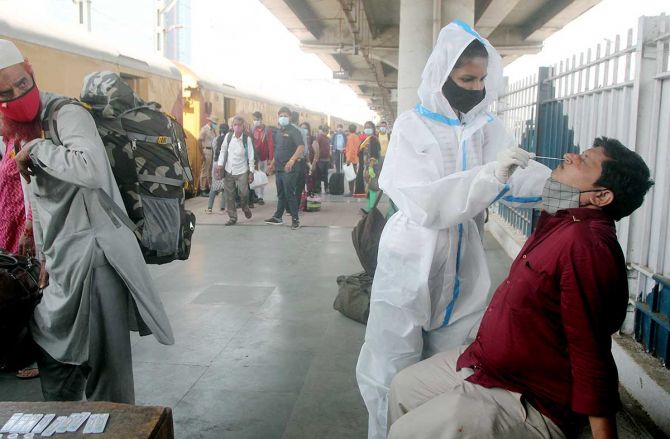
There's always been a lot of talk, right from the start of the pandemic in India, about how herd immunity will come and save us.
But the whole concept of herd immunity is a bit sort of lopsided, especially if new variants arrive.
And there could be still new variants yet to come ie the virus (SARS-CoV-2) will yet produce more variants.
What are your views on the kind of impact new variants can potentially have in India?
See, herd immunity would happen over a period of time.
Whether it has already happened is a matter of dispute.
Some claim it has.
We do not believe it has -- at least, I do not believe it has.
For all of India -- every nook and corner of India -- to have acquired herd immunity by now is a very untenable argument.
But there is also another fundamentally problematic element to herd immunity.
You say that 50 per cent of the people (of India) require to have been infected or vaccinated to get herd immunity, or let's say 60 per cent.
That means 50 to 60 per cent are acquiring immunity through natural infection or through vaccination.
Then the argument with herd immunity is, the virus stops circulating because it is encountering these immune bodies repeatedly.
Therefore, the remaining 40 per cent are not exposed to the virus because there is a protective cordon of the immunised 60 per cent, which guards the remaining 40 per cent.
Now, firstly, we have to assume that the immunity is going to be long lasting in these 60 per cent.
But more importantly, if anybody out of these 40 per cent steps out of that crowd, goes to another place in India, goes to another part of the world, where only 20 or 30 per cent have been affected, then they're no longer protected by that cordon of immunity.
They are vulnerable.
If I have not been infected or I have not been vaccinated and tomorrow I go to another part of the country or world, where the virus is very active, all the herd immunity I might have had in Delhi will not protect me over there.
So, we must differentiate between herd immunity at the population level and immunity at the personal or individual level.
I believe it's important for us to have immunity at the individual level too.
Herd immunity at the population level will come, but over a long period of time.

But do you think that the new variants will affect us in the same way that the original strain has affected us?
How can it affect us as a country?
The general rule of thumb in respiratory viruses is -- though this is a new virus and we still do not know enough about it -- that there's a trade-off between virulence and infectivity.
The more virulent you are, the less infective you are because otherwise you'll be exhausting your own host and writing your own certificate of extinction.
On the other hand, if you are far more infectious, but not very virulent, you can still survive in this world as a species.
That is the logic of natural selection and evolutionary biology.
According to that, the more infectious virus is unlikely to have become more virulent.
It might stay at the same level of virulence or even have lowered the level of virulence.
So, what we have to guard against is this faster spread, but not be very terrified about it becoming much deadlier.
Of course, the more number of cases, the more number of persons affected and the number of serious cases and the number of deaths will rise proportionately, but not disproportionately.
We still have to try and contain the spread in any case.

The government is already rolling out two vaccines for all of the country.
It's going to be available free.
But many also feel there might be access, at some point, to some more expensive vaccines one can pay for, whether it's Pfizer, whether it's Moderna.
The burning question being asked repeatedly: When the vaccine comes, should I opt to get vaccinated?
Secondly, if the paying public - those more well to do or well-heeled -- have, sometime down the road, access to Moderna, Pfizer, what should they opt for?
Should they wait for Moderna and Pfizer to eventually arrive, at a cost?
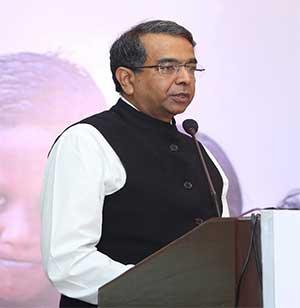 IMAGE: Dr K Srinath Reddy
IMAGE: Dr K Srinath ReddyWhether Pfizer and Moderna will be given approval for sale in India, that depends upon our regulator.
It may not be acquired by the government for large widespread public immunisation programmes
But whether individuals can purchase it, like, for example, as you put it: Some private individuals may want to purchase it or some employer may want to give it to their factory workers or for their office employees.
That happening all depends upon whether they get the regulatory approval or not, for sale in India.
That is still not clear.
That may not be clear for yet a while.
Pfizer seems to have applied.
I'm not sure whether Moderna has applied or not.
We have not seen anything in the public domain that either of them has been given an approval.

Supposing you are 80 years old and realise you're probably going to have access by June-July 2021, or a little later, to one of the vaccines being rolled out by the government.
Should you go for that?
Or wait for Pfizer or Moderna to come?
Or should you opt in for the government vaccination programme and then if Moderna and Pfizer come along and take one of those as well?
Well, I would not say that.
If you have got two doses of the AstraZeneca vaccine, being produced by the Serum Institute, which is a good vaccine, I think that should give reasonable amount of immunity based on whatever trial evidence is available.
With Pfizer and Moderna (by the time it arrives in India, if it does) we would, by then, also have a little more data on the allergic reactions that are being reported.
So, we will have to take those issues also into consideration.
But I would not say that because one vaccine is reporting 90 or 95 per cent efficacy and another is reporting 60 per cent or say 80 per cent efficacy that, that should be the factor for determination of which vaccine to take.

India's vaccination programme for the general public is something that nobody has ever seen before.
There are huge numbers -- vials, people administering etc.
But there's also been talk about how the vaccine should not be administered to the public free.
What is your view on the plusses and minuses of there being a small minimum fee for it?
My view is very clear.
As a public health person, I would say that anybody who requires immunisation against COVID-19, and wants it, should be given it free, because this is what is called, in the language of economists, a public good.
It is not only for myself that I am taking the vaccine, though I am trying to protect myself.
But if I do not protect myself and get infected, I am not the only one affected.
These are, what the economists call negative externalities.
If I go out and infect five others, who may go out and infect 10 others, ultimately, overall, my decision might end up affecting about 100 others.
It is in the interest of society to limit the infection.
It is the duty of the society to provide vaccines to people in an epidemic, so that the infection does not spread from one person to another.
Therefore, I believe it should be given free.
If there are people who want to jump the queue and get it ahead of time, import vaccines or something like that, let them pay for it.
In government programmes, vaccines should always be given free.
Feature Presentation: Ashish Narsale/Rediff.com


